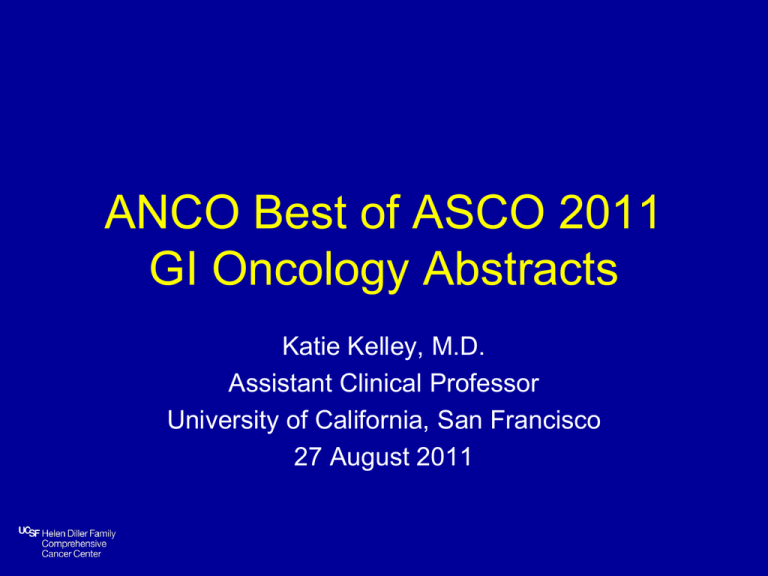
ANCO Best of ASCO 2011
GI Oncology Abstracts
Katie Kelley, M.D.
Assistant Clinical Professor
University of California, San Francisco
27 August 2011
GI Oncology Abstracts
• Colorectal:
– Abstract 3503: NSABP R-04
– Abstract 3510: PRIME
– Abstract 3511: KRAS G13D
• Gastric:
– Abstract 4003: CALGB 80101
– Abstract LBA 4002: CLASSIC
• GIST:
– Abstract LBA1: SSGXVIII/AIO
The Impact of Capecitabine and
Oxaliplatin in the Preoperative
Multimodality Treatment of Patients
with Carcinoma of the Rectum:
NSABP R-04
MS Roh, GA Yothers, MJ O'Connell, RW Beart, HC Pitot, AF
Shields, DS Parda, S Sharif, CJ Allegra, NJ Petrelli, JC
Landry, DP Ryan, A Arora, TL Evans, GS Soori,
L Chu, RV Landes, M Mohiuddin, S Lopa, N Wolmark
ASCO June 4, 2011
1 pm
Abstract #3503
Adenocarcinoma of rectum amenable to surgical
resection located < 12 cm from anal verge
STRATIFICATION
Gender
Clinical Tumor Stage II or III
Intent for Type of Surgery (sphincter saving; non-sphincter saving)
RANDOMIZATION
Group 1
5FU (CVI 225mg/m2 5d/week)
+
4600cGy + 540-1080cGy
Group 2
5FU (CVI 225mg/m2 5d/week) +
Oxaliplatin 50 mg/m2/week X 5
+
4600cGy + 540-1080cGy
Group 3
Capecitabine 825 mg/m2 PO BID +
4600cGy + 540-1080cGy
SURGERY
Group 4
Capecitabine 825 mg/m2 PO BID +
Oxaliplatin 50 mg/m2/week X 5
+
4600cGy + 540-1080cGy
Abstract #3503
Gastrointestinal Toxicity
5-Fu or CAPE vs addition of Oxaliplatin
GI Toxicity**
No Oxali
Oxali
Total
< Grade 3 diarrhea
581
534
1115
Grade 3/4 diarrhea
41
97
138
622
631
1253
15.4
P-value
0.0001
Total Patients
Incidence (%)
6.6
**CTCAE Version 3.0
No Oxali
Oxali
0.04
0.08
0.12
0.16
0.2
Abstract #3503
Surgical Downstaging (SD) by Treatment
5-FU vs Capecitabine
SD Status
5-FU
Cape
Total
without SD
149
144
293
with SD
39
43
82
188
187
375
20.7
15.2-27.2
23.0
17.2-29.7
P-value
.62
Total Patients*
SD Rate (%)
95% CI
5-FU
Cape
0.15
0.2
0.25
0.3
*Restricted to patients without pre-trial intent for SSS
Abstract #3503
Sphincter Saving Surgery by Treatment
Oxaliplatin vs None
SSS Status
No Oxali
Oxali
Total
without SSS
212
231
443
with SSS
370
353
723
Total Patients
582
584
1166
SSS Rate (%)
95% CI
63.6
59.5-67.5
60.4
56.3-64.4
P-value
.28
No Oxali
Oxali
0.56
0.58
0.6
0.62
0.64
0.66
0.68
Abstract #3503
Pathologic Complete Response by Treatment
Oxaliplatin vs None
pCR Status
No Oxali
Oxali
Total
without pCR
469
457
926
with pCR
111
121
232
Total Patients
580
578
1158
pCR Rate (%)
95% CI
19.1
16.0-22.6
20.9
17.7-24.5
P-value
0.46
No Oxali
Oxali
0.16
0.18
0.2
0.22
0.24
0.26
Abstract #3503
NSABP R-04
Conclusions
• Administration of capecitabine with preoperative
RT achieved rates similar to CVI 5-FU for
– Surgical downstaging
– Sphincter saving surgery
– Pathologic complete response
• Addition of oxaliplatin did not improve outcomes
and added significant toxicity
• Longer follow up will be needed to assess localregional tumor relapse, DFS and OS
Abstract #3503
Final Results From PRIME: Randomized Phase 3
Study of Panitumumab (pmab) With FOLFOX4 for
1st-line Metastatic Colorectal Cancer (mCRC)
Jean Yves Douillard,1 Salvatore Siena,2 James Cassidy,3
Josep Tabernero,4 Ronald Burkes,5 Mario E. Barugel,6 Yves
Humblet,7 David Cunningham,8 Feng Xu,9 Kartik Krishnan9
René Gauducheau, Nantes, France; 2Ospedale Niguarda Ca’ Granda, Milan, Italy;
3The Beatson West of Scotland Cancer Centre, Glasgow, United Kingdom; 4Vall d'Hebrón
University Hospital, Barcelona, Spain; 5Mount Sinai Hospital, Toronto, Canada; 6Hospital de
Gastroenterología, Buenos Aires, Argentina; 7Centre du Cancer de l'Université Catholique de
Louvain, Brussels, Belgium; 8The Royal Marsden NHS Foundation Trust, London, United
Kingdom; 9Amgen Inc., Thousand Oaks, California;
1Centre
Abstract #3510
PFS by KRAS Mutation Status
Final Analysis
WT KRAS
MT KRAS
100%
Proportion Event-Free
Proportion Event-Free
100%
90%
80%
70%
60%
50%
40%
30%
20%
10%
0%
0
2
4
6
8
10 12 14 16
18
20 22 24
26
28 30 32 34
36 38 40 42
44
90%
80%
70%
60%
50%
40%
30%
20%
10%
0%
0
2
4
6
8
10 12 14 16
18
Months
Events
n (%)
26
28 30 32 34
36 38 40 42
44
Months
Median
(95% CI)
months
Panitumumab +
FOLFOX4
270 / 325
(83)
10.0 (9.3 – 11.4)
FOLFOX4
280 / 331
(85)
8.6 (7.5 – 9.5)
HR = 0.80 (95% CI: 0.67 – 0.95)
Log-rank p-value = 0.01
20 22 24
Median
(95% CI)
months
Events
n (%)
Panitumumab
+ FOLFOX4
204 / 221
(92)
7.4 (6.9 – 8.1)
FOLFOX4
196 / 219
(89)
9.2 (8.1 – 9.9)
HR = 1.27 (95% CI: 1.04 – 1.55)
Log-rank p-value = 0.02
Abstract #3510
OS by KRAS Mutation Status
Final Analysis
WT KRAS
MT KRAS
100%
Proportion Event-Free
Proportion Event-Free
100%
90%
80%
70%
60%
50%
40%
30%
20%
10%
0%
0
2
4
6
8
10 12 14 16 18 20 22 24 26 28 30 32 34 36 38 40 42 44 46
90%
80%
70%
60%
50%
40%
30%
20%
10%
0%
0
2
4
6
8
10 12 14 16
Months
20 22 24
26
28 30 32 34
36 38 40 42
44
Months
Events
n (%)
Median (95% CI)
months
Panitumumab+
FOLFOX4
214 / 325
(66)
23.9 (20.3 - 27.7)
FOLFOX4
231 / 331
(70)
19.7 (17.6 - 22.7)
HR = 0.88 (95% CI: 0.73 – 1.06)
Log-rank p-value = 0.17
18
Events
n (%)
Median (95% CI)
months
Panitumumab+
FOLFOX4
179 / 221
(81)
15.5 (13.1 - 17.6)
FOLFOX4
177 / 219
(81)
19.2 (16.5 - 21.7)
HR = 1.17 (95% CI: 0.95 – 1.45)
Log-rank p-value = 0.15
Abstract #3510
Objective Response by KRAS Status (Central
Review)
WT KRAS
Objective response rate,
% (95% CI)
Odds ratio (95% CI)b
Panitumumab
+ FOLFOX4
(n = 317)a
57
(51 – 63)
MT KRAS
FOLFOX4
(n = 324)a
Panitumumab
+ FOLFOX4
(n = 215)a
FOLFOX4
(n = 211)a
48
(42 – 53)
40
(33 – 47)
41
(34 – 48)
1.47 (1.07 – 2.04)
p = 0.02
0.98 (0.65 – 1.47)
p = 0.92
Complete response, %
<1
<1
0
0
Partial response, %
57
47
40
41
Stable disease, %
29
36
37
43
Progressive disease, %
7
11
13
11
aIncluded
only patients with baseline measurable disease per central review
bAdjusted for geographic region and ECOG performance status score
All responses were required to be confirmed at least 28 days after the response criteria were first met
Abstract #3510
PFS, OS, and Objective Response by Worst Grade Skin Toxicity
in Patients With WT KRAS Tumors Receiving Panitumumab*
OS
100%
90%
80%
70%
60%
50%
40%
30%
20%
10%
0%
Proportion Alive
Proportion Event-Free
PFS
0
2
4
6
8
10 12 14 16 18 20 22 24 26 28 30 32 34 36 38 40 42
100%
90%
80%
70%
60%
50%
40%
30%
20%
10%
0%
0
2
4
6
8 10 12 14 16 18 20 22 24 26 28 30 32 34 36 38 40 42 44 46
Months
Months
Events
n (%)
Median (95% CI)
months
Grade 2-4
208 / 250 (83)
11.3 (9.9 – 13.2)
Grade 0-1
55 / 64 (86)
6.1 (5.3 – 9.2)
HR (Gr 2-4: 0-1) = 0.56 (95% CI: 0.41 – 0.76)
Log-rank p-value = 0.002
Objective response rate, % (95% CI)
Odds Ratio (95% CI)
p-value
Events
n (%)
Median (95% CI)
months
Grade 2-4
157 / 250 (63)
27.7 (23.8 – 30.8)
Grade 0-1
50 / 64 (78)
11.5 (9.1 – 20.2)
HR (Gr 2 - 4 : 0 - 1) = 0.53 (95% CI: 0.38 - 0.73)
p-value = 0.0001
Skin Toxicity Worst
Grade 0-1
(n = 61)
Skin Toxicity Worst
Grade 2-4
(n = 246)
41 (29 – 54)
63 (57 – 69)
2.55 (1.36, 4.80)
p = 0.003
• Median (Q1, Q3) time to worst grade 2 or greater skin toxicity was 53 (13, 118) days
Abstract #3510
Conclusions
•
In the final analysis of PRIME, panitumumab plus FOLFOX4 vs FOLFOX4 in
patients with WT KRAS mCRC showed:
– Statistically significant improvement in PFS
– Trend toward improved OS
– Statistically significant improvement in response rate
•
A quarter of patients with WT KRAS enrolled in the FOLFOX4 “alone” arm
received subsequent anti-EGFR therapy after the protocol treatment phase was
complete but before the final efficacy analyses, likely affecting OS results
•
In patients with MT KRAS tumors, outcomes were inferior for panitumumab +
FOLFOX4 vs FOLFOX4 alone
•
Adverse event rates were consistent with the primary analysis and as expected
for an EGFR inhibitor
•
In patients receiving panitumumab with WT KRAS mCRC who develop grade 2–
4 skin toxicity, PFS, OS, and objective response are improved vs patients with
skin toxicity grade 0–1
Abstract #3510
Influence of KRAS G13D mutations
on outcome in patients with
metastatic colorectal cancer (mCRC)
treated with first-line chemotherapy
with or without cetuximab
S. Tejpar*,
C. Bokemeyer, I. Celik, M. Schlichting,
U. Sartorius, E. Van Cutsem
*University Hospital Gasthuisberg, Leuven, Belgium
Abstract #3511
Objectives
• To investigate the influence of KRAS G13D mutations on
clinical outcome in mCRC patients treated in the first-line
setting
– A pooled exploratory analysis of the CRYSTAL and OPUS
studies
• KRAS G13D vs KRAS wt
• KRAS G13D vs other KRAS mutations
• To explore the impact of KRAS G12V mutations
–
A marker of poor prognosis ? (RASCAL study)1
Abstract #3511
wt, wild-type
1Andreyev
H, et al. Br J Cancer 2001;85:692-6
Are all KRAS mutations equal?
• KRAS codon 13 mutations are more frequent in CRC
than other tumor types (lung and pancreas)1
• KRAS codon 13 mutations exhibit weaker in vitro
transforming activity than codon 12 mutations2
• Isogenic cell lines showed3
– KRAS G12V mutated CRC cells were insensitive to cetuximab
– KRAS G13D mutated CRC cells were sensitive to cetuximab
Abstract #3511
1Welcome
Trust Sanger Institute; http://www.sanger.ac.uk/genetics/CGP/cosmic/
2Guerro S, et al. Cancer Res 2000;60:6750-6756
3De Roock W, et al. JAMA 2010;304:1812-1820
Chemotherapy arm: KRAS mutation status
and outcome in the pooled analysis
PFS
OS
wt
mt G13D
mt G12V
mt Other
wt
mt G13D
mt G12V
mt Other
(n=447)
(n=41)
(n=53)
(n=148)
(n=447)
(n=41)
(n=53)
(n=148)
Median PFS
7.6
6.0
8.8
8.1
Median OS
19.5
14.7
17.8
17.7
[95% CI]
[7.4-8.4]
[5.4-7.8]
[7.2-9.5]
[7.2-9.4]
[95% CI]
[17.8-21.1]
[12.4-19.4]
[15.5-21.7]
[15.3-20.5]
1.0
1.0
0.9
0.9
0.8
Probability of OS
Probability of PFS
0.8
0.7
0.6
0.5
0.4
0.3
0.7
0.6
0.5
0.4
0.3
0.2
0.2
0.1
0.1
0.0
0.0
0
4
8
Months
12
16
KRAS G13D vs other mut: HR 1.54, p=0.0847
mt, mutant; wt, wild-type
20
0
6
12
18
24
30
Months
36
42
48
54
60
KRAS G13D vs other mut: HR 1.39, p=0.0988
Abstract #3511
KRAS mutation status and treatment effect: PFS
Study
Population
Median (months)
chemotherapy + cetuximab vs. chemotherapy
HR [95% CI]
Pooled Analysis
KRAS wt (n=845)
9.6 vs 7.6
0.66 [0.55-0.80]
KRAS mt-G13D (n=83)
7.4 vs. 6.0
0.60 [0.32-1.12]
KRAS mt-G12V (n=125)
5.6 vs. 8.8
1.55 [0.94-2.56]
KRAS mt-other (n=325)
6.7 vs. 8.1
1.37 [1.02-1.84]
KRAS wt (n=666)
9.9 vs. 8.4
0.69 [0.56-0.86]
KRAS mt-G13D (n=60)
7.5 vs. 7.4
0.72 [0.33-1.57]
KRAS mt-G12V (n=91)
6.7 vs. 8.2
1.43 [0.79-2.59]
KRAS mt-other (n=246)
7.1 vs. 7.7
1.19 [0.84-1.68]
KRAS wt (n=179)
8.3 vs. 7.2
0.57 [0.37-0.88]
KRAS mt-G13D (n=23)
5.7 vs. 5.6
0.40 [0.13-1.21]
KRAS mt-G12V (n=34)
4.4 vs. 9.4
1.89 [0.73-4.86]
KRAS mt-other (n=79)
5.5 vs. 8.6
2.06 [1.12-3.76]
CRYSTAL
OPUS
0.1
0.5
Benefit under chemotherapy + cetuximab
mt, mutant; wt, wild-type
1.0
2.0
Benefit under chemotherapy alone
Abstract #3511
KRAS mutation status and treatment effect: tumor
response
Study
Population
Rates [%]
chemotherapy + cetuximab vs. chemotherapy
OR [95% CI]
Pooled Analysis
KRAS wt (n=845)
57.3 vs. 38.5
2.17 [1.64-2.86]
KRAS mt-G13D (n=83)
40.5 vs. 22.0
2.41 [0.90-6.45]
KRAS mt-G12V (n=125)
30.6 vs. 45.3
0.54 [0.26-1.12]
KRAS mt-other (n=325)
30.5 vs. 43.2
0.58 [0.36-0.91]
KRAS wt (n=666)
57.3 vs. 39.7
2.08 [1.52-2.84]
KRAS mt-G13D (n=60)
35.5 vs. 17.2
2.38 [0.71-7.98]
KRAS mt-G12V (n=91)
33.3 vs. 40.0
0.77 [0.32-1.82]
KRAS mt-other (n=246)
29.5 vs. 39.5
0.63 [0.37-1.07]
KRAS wt (n=179)
57.3 vs. 34.0
2.53 [1.37-4.66]
KRAS mt-G13D (n=23)
54.5 vs. 33.3
2.47 [0.46-13.4]
KRAS mt-G12V (n=34)
23.8 vs. 61.5
0.20 [0.04-0.90]
KRAS mt-other (n=79)
33.3 vs. 55.9
0.44 [0.18-1.11]
CRYSTAL
OPUS
0.1
0.5
Benefit under chemotherapy alone
mt, mutant; wt, wild-type
1.0
2.0
10.0 20.0
Benefit under chemotherapy + cetuximab
Abstract #3511
Treatment interaction
• Significant treatment interaction by KRAS mutation
status was observed for KRAS G13D vs other KRAS
mutants
– Response (p<0.0001)
– PFS (p<0.0001)
– OS (p=0.0201)
• Relative treatment effects were similar for KRAS G13D
and KRAS wt patients
Abstract #3511
Conclusions
• A heterogeneous treatment effect according to KRAS mutation
status was confirmed in the CRYSTAL and OPUS studies
• KRAS G13D mutations are associated with poor prognosis in mCRC
patients treated first-line:
– More pronounced in those treated with FOLFOX4 alone
• Patients with KRAS G13D mutant mCRC appear to benefit from
first-line chemotherapy + cetuximab:
– Both in CRYSTAL and OPUS studies
– At a lower absolute effect level than for patients with KRAS wt mCRC
– A reversal of the poor prognosis observed with chemotherapy alone
• Patients with other KRAS mutations do not benefit from first-line
chemotherapy + cetuximab
Abstract #3511
Postoperative adjuvant chemoradiation for gastric
or GE junction adenocarcinoma using ECF before
and after 5-FU/radiotherapy compared to bolus 5FU/LV before and after 5-FU/radiotherapy:
Intergroup trial CALGB 80101
CS Fuchs, JE Tepper, D Niedzwiecki, D Hollis,
HJ Mamon, RS Swanson, DG Haller,
T Dragovich, SR Alberts, G Bjarnson, CG Willett,
PC Enzinger, RM Goldberg, AP Venook, RJ Mayer
Abstract #4003
CALGB 80101: Study Schema
R
A
N
D
O
M
I
Z
E
5-FU/LV
5-FU IVCI
5-FU/LV
X1
RT
X2
ECF
5-FU IVCI
ECF
X1
RT
X2
5-FU/LV: 5-FU 425 mg/m2 d1-5, LV 20 mg/m2 d1-5
RT: 45 Gy (1.8 Gy X 25 fractions) with 5-FU 200 mg/m2/d CI
ECF (pre-RT): Epirubicin 50 mg/m2 d1, Cisplatin 60 mg/m2 d1, &
5-FU 200 mg/m2/d CI d1-21
ECF (post-RT): Epirubicin 40 mg/m2 d1, Cisplatin 50 mg/m2 d1, &
5-FU 200 mg/m2/d CI d1-21
Abstract #4003
Major (Grade ≥ 3) Adverse Events
5FU/LV
ECF
Nausea
17%
15%
Diarrhea
15%
7%
Mucositis
15%
7%
Dehydration
9%
4%
Anorexia
16%
13%
Fatigue
11%
13%
Neutropenia
52%
48%
Grade ≥ 4 Neutropenia
33%
19%
3% (8)
0% (1)
Death
Abstract #4003
CALGB 80101
Overall Survival by Treatment Arm
1.0
O v e ra ll S u rv iv a l b y A rm
0.6
0.4
0.2
P, log rank = 0.80
0.0
Proportion Surviving
0.8
ECF
5 -F U
0
1
2
3
4
5
6
7
Y e a rs fro m S tu d y E n try
Abstract #4003
CALGB 80101 Conclusion
Following curative resection of gastric or GE jxn
adenocarcinoma, post-operative chemoradiotherapy
using ECF & 5-FU/RT does not improve survival when
compared to 5-FU/LV & 5-FU/RT
Abstract #4003
Adjuvant capecitabine and oxaliplatin for
gastric cancer: results of the Phase III
CLASSIC trial (LBA4002)
Yung-Jue Bang
on behalf of Young-Woo Kim, Han-Kwang Yang, Hyun Cheol
Chung, Young-Kyu Park, Kyung Hee Lee, Keun-Wook Lee,
Yong Ho Kim, Sang-Ik Noh, Jiafu Ji, Michael Johnston, Florin
Sirzén, Sung Hoon Noh, and the CLASSIC trial investigators
Abstract #LBA 4002
Rationale for CLASSIC
• High recurrence rates following surgical resection of GC
(40%–80%)1,2
• Adjuvant chemotherapy aims to reduce recurrences;
however, there is currently no universally accepted
adjuvant regimen
• INT-01163 and MAGIC4 demonstrated a survival benefit of
postoperative chemoradiotherapy and perioperative
chemotherapy, respectively
• In Asia there is concern regarding the adequacy of
surgery used in these trials
1Gallo
et al. World J Gastroenterol 2006; 2Gunderson. Semin Radiat Oncol 2002
3Macdonald et al. N Engl J Med 2001; 4Cunningham et al. N Engl J Med 2006
Abstract #LBA 4002
CLASSIC study design
Surgically (D2)
resected Stage II,
IIIA, or IIIB GC,
6 weeks prior to
randomization
No prior
chemotherapy or
radiotherapy
n=1035
R
A
N
D
O
M
I
Z
A
T
I
O
N
n=520
8 cycles of XELOX (6 months)
†
1:1
Capecitabine: 1,000mg/m2 bid, d1–14, q3w
Oxaliplatin: 130mg/m2, d1, q3w
Observation: No adjuvant therapy
n=515
• Primary endpoint: 3-year DFS‡
• Secondary endpoints: overall survival and safety profile
†Stratified
by stage and country with age, sex, and nodal status as covariates
project: 3-year DFS and 5-year overall survival are strongly associated,
Burzykowski et al. ASCO 2009
‡GASTRIC
Abstract #LBA 4002
Primary endpoint (3-year DFS) met
at interim analysis
3-year DFS
1.0
74%
0.8
XELOX, n=520
0.6
60%
Observation, n=515
0.4
0.2
HR=0.56 (95% CI 0.44–0.72)
P<0.0001
0.0
0
No. left
XELOX 520
Observation 515
6
12
18
24
30
36
42
48
74
58
30
22
10
6
Time (months)
443
414
410
352
333
286
246
209
166
147
ITT population; DFS = disease-free survival
Median follow-up 34.4 months (range 16–51)
Abstract #LBA 4002
Summary
• Adjuvant XELOX following D2 dissection significantly
improved 3-year DFS compared with observation alone
• The benefit of XELOX was observed for all disease stages
• The safety of adjuvant XELOX in GC was consistent with
the known safety profile of XELOX, with no new or
unexpected findings
• Longer follow-up is needed to determine the effect of
adjuvant XELOX on overall survival
Abstract #LBA 4002
[TITLE]
Abstract #LBA 1
Abstract #LBA 1
[TITLE]
Abstract #LBA 1
[TITLE]
[TITLE]
Abstract #LBA 1
Abstract #LBA 1
[TITLE]
Abstract #LBA 1
[TITLE]
[TITLE]
Abstract #LBA 1
Abstract #LBA 1
[TITLE]
[TITLE]
Abstract #LBA 1
Abstract #LBA 1
[TITLE]
End of GI Oncology Section

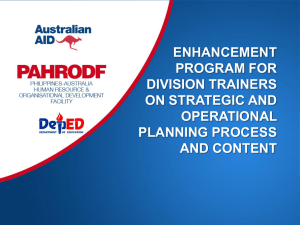
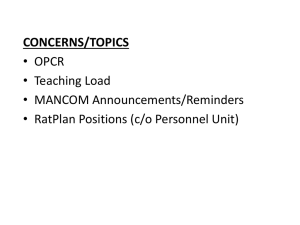
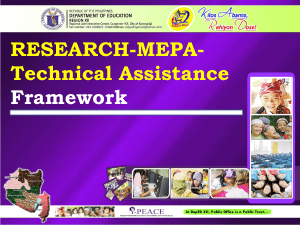

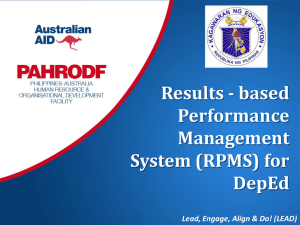

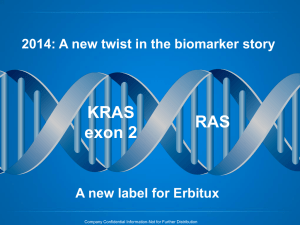
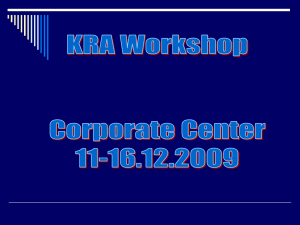
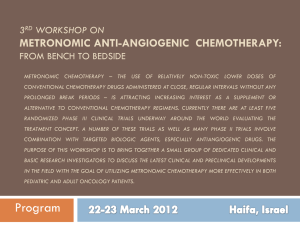
![John McDonald, Director, Claremont Colleges Library [PPT]](http://s2.studylib.net/store/data/005395875_1-1935e1d320e49e3ca4701d9a87404d36-300x300.png)